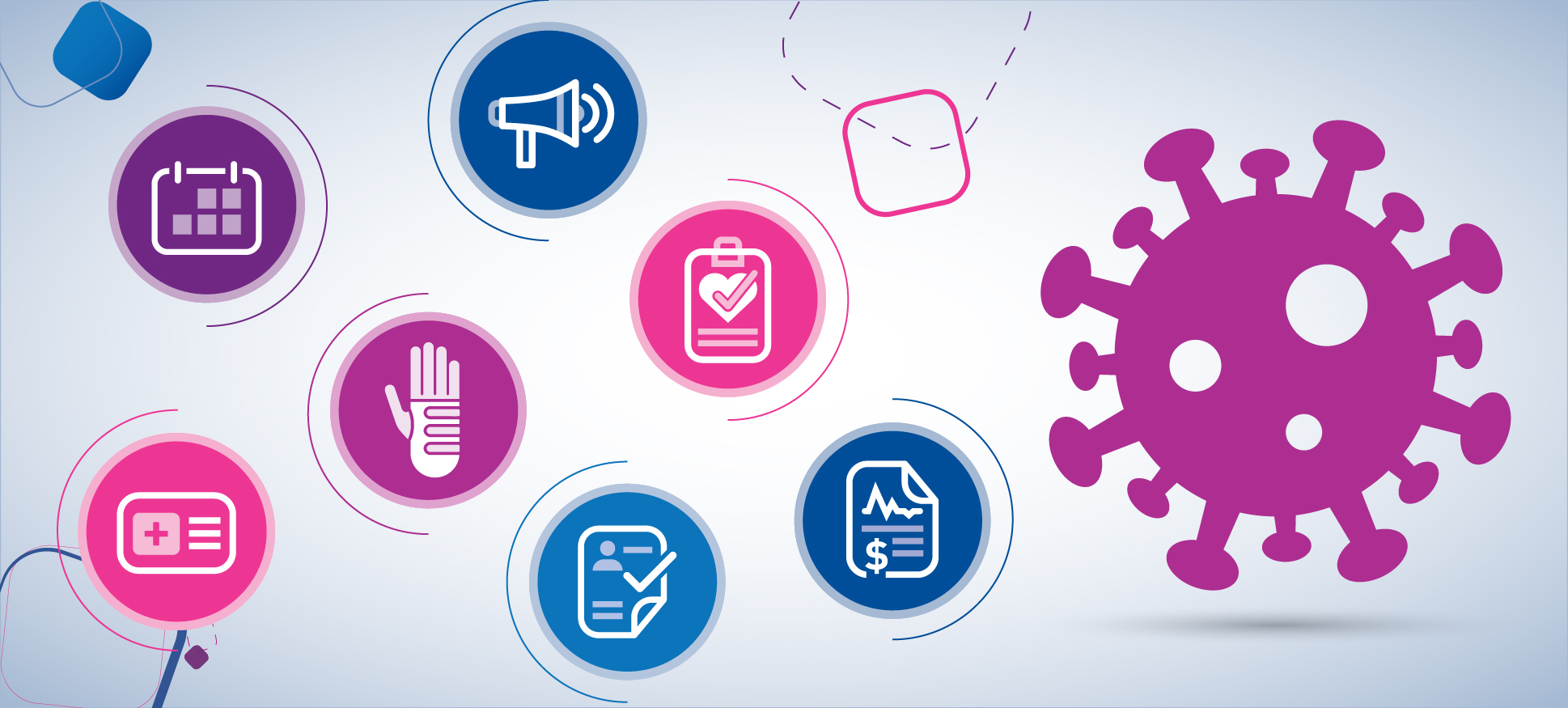Tag: patient estimates

Earlier this year, Experian Health teamed up with PYMNTS to ask more than 2300 consumers about their digital healthcare habits. The results confirmed that consumers are eager to use digital channels, but still experience challenges in finding options that meet their expectations. The Digital Healthcare Gap: Streamlining the Patient Journey examines how healthcare providers currently use digital tools to allow patients to book appointments, obtain test results and make payments. It also examines how providers are closing gaps. This article summarizes the key insights that will help providers create a seamless digital experience and improve patient engagement. Download the report to get the full study, and to learn how healthcare providers are using digital channels to improve care and drive engagement. How are healthcare providers using digital channels to streamline access to care? While most patients still prefer to interact with healthcare providers in person or by phone, digital methods are increasingly popular. For example, Experian and PYMNTS data show that: 1 in 5 patients used digital channels to schedule appointments within the previous year. 1 in 3 patients used patient portals to fill out registration forms. 1 in 4 patients used digital methods to pay for healthcare. Urgent care patients were the most likely to schedule appointments online, with 17% using patient portals, 16% scheduling directly through practice websites and 5% booking by text message. Patient portals were also the most popular digital channel among patients booking appointments with family practices. These insights suggest that patients want on-demand patient access and a range of options to book, register and pay for care in a way that’s most convenient for them. When they have that choice, many opt for digital methods, though results vary by type of provider. Patient portals are emerging as the most popular channel because they allow patients to securely access and manage their healthcare information in one place, whenever and wherever they like. Missed us at the MUSE Inspire Conference? Contact us for more conversations about opening healthcare’s digital front door. How can providers better engage patients using digital healthcare solutions? Despite their enthusiasm, many patients run into challenges when using patient portals, especially when making payments. Obtaining accurate cost estimates before coming in for care was a major pain point for 15% of patients surveyed. Portals are an obvious solution, but only 24% of patients said they had access to portals that include this feature. Even among those patients with access to “estimate-enabled” portals, only 6% said they knew their out-of-pocket costs in advance, which may point to communication or usability issues. The ability to receive cost estimates in advance of treatment has a major impact on how satisfied patients feel with their overall care experience. Nearly 85% of patients said they were satisfied with their care, but those who did not receive cost estimates for their most recent appointments tended to be less satisfied. The portion of urgent care patients satisfied with their experience dropped to 74% when out-of-pocket expenses weren’t known in advance. Experian Health’s Patient Estimates can help address these gaps. This web-based pricing tool gives patients accurate cost estimates before their treatment and offers advice for financial assistance and charity options. Patient Financial Advisor complements this by delivering pre-service estimates of the patient’s responsibility straight to their mobile devices. With this solution, patients get a text message with a secure link to their cost estimates and payment options. Providers that offer a convenient and transparent financial experience through these types of digital tools are likely to see improved patient engagement and more efficient patient collections. Tom Cox, President of Experian Health, says that digitally-enabled convenience is the secret to better patient engagement. “Patients are consumers before they are patients. They may not be experts in medicine, but when it comes to convenient and efficient scheduling, registration, estimates, payments, communication, and flexible delivery of these services, the consumer becomes the de facto expert. Healthcare is quickly approaching the point where a standard of convenience and ease of use – primarily delivered via digital tools – will result in patient attrition for those failing to meet the standard. The ’innovation’ needed is to reach parity with the experiences consumers have in their other service interactions.” “Healthcare is quickly approaching the point where a standard of convenience and ease of use – primarily delivered via digital tools – will result in patient attrition for those failing to meet the standard.” - Tom Cox, President at Experian Health How can digital healthcare solutions attract and retain new patients? The research also found that opening the digital front door can supercharge efforts to attract new patients. 3 in 10 patients use digital methods to find and select providers, with 1 in 10 using online reviews as part of their search. Nearly 2 in 10 struggle to find the professionals they need. Building a consistent online presence can help increase providers’ “discoverability” and signal a commitment to digital healthcare that so many patients desire. Providers that offer easy and reliable digital tools are also going to be more likely to attract and retain new patients. With 20% of patients saying portals are complicated to use, and 13% saying they lack functionality, providers that offer streamlined digital services are going to be more attractive. Building on the existing momentum with online self-scheduling and self-service patient registration can make it easier for patients to choose and register with new providers. Cox recognizes that digital solutions are not a simple fix – but worth the effort. “As consumers, we take something like scheduling for granted. What goes on behind the scenes is pretty complicated, however. In the case of scheduling a medical visit, there are specific time slots, physician schedules, how to address cancellations and the need for referrals, among many other variables.... It can be challenging for a healthcare provider to aggregate disparate data into a digital tool that’s easy for patients to engage with. That’s why solution partners like Experian Health are critical to help deliver a better patient experience.” Find out more about how Experian Health’s tried and tested digital tools can help providers streamline the patient journey.

Recent data suggests that implementing transparent pricing has been a bumpy ride for some healthcare organizations. The federal hospital price transparency rule, which took effect in January 2021, requires hospitals to provide “clear, accessible pricing information” to make it easier for healthcare consumers to compare prices before going to the hospital. But a recent survey by Patient Rights Advocate found that fewer than 15% of hospitals are fully compliant with the requirements for machine-readable files and consumer-friendly shoppable lists. The Centers for Medicare and Medicaid Services (CMS) confirmed that around 345 warning notices and 136 corrective action plan requests were sent to non-compliant hospitals between January 2021 and March 2022. Providers that fail to improve healthcare price transparency not only risk hefty penalties, they also alienate patients who want a financial experience without surprise medical bills. It’s not an unreasonable request – how can patients take control of their health finance decisions without upfront, accurate and accessible pricing information? Proceeding with treatment without knowing the cost and then waiting months for a bill is a far from satisfying patient experience. Providers that want to satisfy both patients and policy-makers must do more to ease frictions in patient billing. Regulatory change is only part of the solution. With the right digital payment tools and strategies, providers can eliminate many of their patients’ price transparency pain points and improve their financial journey. Pain point 1: finding accurate price estimates prior to care One of the biggest pain points for patients is not having advance knowledge of the cost of care. In a survey conducted by Experian Health and PYMNTS, 15% of patients said they struggled to obtain accurate cost estimates before appointments and procedures, which curbed their satisfaction with their overall care experience. This figure rose among the most active users of digital services, with 21% of digital-first patients saying they faced challenges receiving a breakdown of estimated medical bills. Given that this group also said they would be more likely to switch providers based on the quality of digital services, getting transparent pricing right is high stakes. Providers can improve healthcare price transparency and solve this pain point by giving patients easy-access pricing information upfront. Patient Estimates can offer patients clear and easy-to-understand personalized estimates of their financial responsibility. This is done by drawing on key provider data sources and including the patient’s current insurance benefits information. Patients get estimates and payment options directly to their mobile devices, so they can choose the pathway that suits them best. This puts them in control of their payments, so they’re less likely to hit roadblocks as they move through their financial journey. Pain point 2: complex payment systems are difficult to navigate Another way to allow patients to feel in charge of their own financial journey is to offer a choice of convenient and flexible digital tools and services. A little over 20% of digital-first patients said they’d experienced difficulties when viewing invoices, setting up payment plans and making payments. As younger patients form a greater portion of new patient cohorts, there’s likely to be an increasing push for digital payment methods. Providers can engage patients before and after treatment using a text-to-mobile service such as Patient Financial Advisor, which shows patients their estimated responsibility and points them toward best-fit payment plans. This works well alongside PatientSimple, a self-service portal that puts the power in patients’ hands, allowing them to generate their own price estimates, apply for charity care and set up payment plans. Pain point 3: understanding medical bills (even with estimates) Unfortunately, many patients struggle to make sense of medical bills, even when estimates are available. Seven out of ten consumers say they would like to know the cost of care in advance, but more than half also say they’ve never thought to look for that information. A Health Affairs study found that utilization of a price transparency tool increased by 600% following marketing efforts – but patients largely chose the same clinicians as before. Even with upfront pricing information, most consumers don’t have the time or resources to assess quality and piece together fragmented bills. Providers can support patients by implementing a price transparency strategy that combines accurate pricing estimates, user-friendly interfaces and easy ways to pay with clear communications. Hospitals are turning to third-party solution providers like Experian Health to help solve their price transparency problems. Find out more about how Experian Health’s solutions can help healthcare providers improve healthcare price transparency and deliver more accurate price estimates, reduce administrative and financial pain points, and create a more satisfying patient experience.

Healthcare’s digital transformation promises patients ever-growing choices in how to access, experience and pay for care. Providers know that opening their digital front door is the key to attracting and retaining loyal consumers. However, deciding on the exact technologies and services to offer can be challenging. A good place to start is to follow the patients’ lead: what digital tools do they say they want? How are they using existing services (or not)? By understanding patients’ attitudes and behaviors, providers can design a digital patient journey that leads to increased patient satisfaction. A new collaborative report by Experian Health and PYMNTS provides fresh insights to inform digital patient engagement strategies. This survey, conducted in January 2022, interviewed over 2000 patients to understand how they’re using digital methods to access healthcare services and their biggest pain points. The findings revealed a need for digital services that foster convenience and choice. Digital-savvy consumers expect user-friendly online options across the care continuum, from scheduling and registration to final payment. Improving these services is also likely to encourage the less digitally confident consumers to try alternative methods and increase access to care. This article offers a snapshot of the key findings that will help providers identify gaps in their digital offerings and build a digital experience that meets consumer expectations. Finding 1: Patients are looking for digital methods to perform most healthcare activities. Patient portals are the most popular method for obtaining test results, with 44% of patients choosing this option. A quarter of patients have used digital methods to pay their medical bills. Digital methods are widely used across the patient journey, from scheduling appointments to receiving test results. Patients expect convenience, flexibility and choices, with many reporting frustrations when they can’t access the digital services they desire. Providers that offer a broad selection of digital patient engagement solutions will be best placed to respond to changing consumer demands. Beyond patient satisfaction, digital tools facilitate better care plan adherence, improve workforce efficiency, and contribute to higher patient collections rates. Finding 2: Patients are satisfied with their healthcare experience but find it challenging to confirm costs and select new providers. 15% of patients report difficulties when obtaining accurate cost estimates for appointments and procedures. Predictably, digital-first patients have the highest expectations of digital systems. They are accustomed to convenient and accessible digital processes elsewhere in the consumer world. Healthcare organizations with an open digital front door will be more attractive to these potential new patients. Digital payments could be a worthwhile investment in this regard. A previous PYMNTS survey found that 63% of patients would consider switching providers if the payment experience wasn’t up to par. To improve the payment experience, providers should consider offering upfront pricing estimates to make it easier for patients to understand and plan for their bills. A tool such as Patient Financial Advisor can act as an online financial concierge for patients, by connecting them with appropriate payment plans and contactless payment methods directly through their mobile devices. Finding 3: Two-thirds of patients use patient portals, but many find portals lack essential payment features. While 62% of patients use portals, this rises to 82% among digital-first consumers and drops to 19% among non-digital consumers. 64% of patients say cost estimates are very or extremely important, but only 24% say they receive estimates. Closing the gap between what patients expect of portals and what’s actually delivered could help narrow the differences in portal usage between different patient groups. Credit and debit cards are currently the most popular payment methods, but patients would use them less often if their preferred digital payment methods were available. Providers should consider combining high-performing patient portals with a range of payment options. Finding 4: Frictionless patient portals could prevent patients from switching providers. 61% of patients say they would switch to a healthcare provider that offers a patient portal. Improving patient portal capabilities is likely to be an important driver in attracting new patients. However, it’s also essential to retain existing patients. More than six in ten patients say they’d switch to a provider that offers a patient portal. This number rises to nearly eight in ten younger patients. A digital-first experience is no longer simply a preference, but an expectation for many consumers. To better engage and retain consumers throughout the patient journey, providers must explore the use of patient portals and other digital solutions to remove digital pain points and meet consumer expectations for a frictionless patient access experience. Download the full report to learn how healthcare providers can relieve digital pain points to offer improved patient care and satisfaction.

According to a recent survey by PYMNTS, many patients want digital healthcare management tools. 76% of survey respondents said they were “very” or “extremely” interested in using at least one digital method to manage interactions with their healthcare providers, rising to 86% among younger patients. This finding echoes Experian Health’s research from our State of Patient Access 2.0 survey. In this survey, we found that the pandemic had cemented consumer expectations around convenient access to care. Providers that wait too long to open their digital front door risk losing consumers to competitors. The “digital front door” describes how a patient can find and access care through online and digital channels. This can include everything from booking appointments and virtual waiting rooms to contactless payments and telehealth. It’s more than just patient access: digital technology can create convenient and connected patient experiences throughout the entire patient journey. The goal is a patient experience that flows seamlessly between in-person interactions and virtual touchpoints, from finding care to post-visit follow-up. Experian Health’s clients revealed that many have embraced digital tools to deliver a patient experience that matches consumer expectations, driven in large part by the pandemic.* Some are planning to invest in their digital front door within the next year, while resource constraints are hampering others in moving forward. Healthcare providers in the early stages of digital transformation may be wondering where to start. Where should they focus limited resources for the biggest gains? The four opportunities that could offer the greatest return on investment are online scheduling, omnichannel communications, contactless payments and productivity-boosting automation. Help patients find and book appointments with easy online scheduling Last year’s State of Patient Access 2.0 survey found that nearly eight in ten consumers prefer to schedule their own appointments at any time, from any device. This trend is set to continue in 2022 and beyond. Many patients have been using online scheduling platforms to book COVID-19 vaccinations and tests, as well as to reschedule care that was delayed during the earlier months of the pandemic. Opening the digital front door with online scheduling offers patients the control, convenience and choice they desire. No-shows are less likely, which leads to higher physician productivity and satisfaction, greater efficiency, lower costs and better patient outcomes in the longer term. Communicate through patients’ preferred channels to boost engagement With the pandemic necessitating so many rules around daily activities, limits on how and when consumers communicate with their providers can feel even more restrictive. Many don’t want to be forced into phone calls at inconvenient times, especially when a simple text reminder or a quick check of their patient portal would do the job. Providers that allow consumers to customize their patient access experience and engage through their preferred channels will be rewarded with increased patient loyalty. Omnichannel solutions also help to build a consistent care experience. A digital process that looks and feels the same every time, regardless of which platform the patient uses, will make navigating the care process much easier. Additionally, patients will be more likely to schedule appointments and fill out forms in a timely manner on their own, which can alleviate staffing resource constraints. A digital front door can help with contactless payments One part of the healthcare experience that can be notoriously tricky to navigate is paying for care. PYMNTS found that 63% of patients would consider switching healthcare providers over a bad payment experience. Providers can make it easier for patients to pay by offering upfront estimates of what the patient’s portion of the bill is likely to be, running automated coverage checks to make sure no insurance is missed, and sending automated reminders with links to contactless payment methods. According to PYMNTS, less than 20% of patients pay for care before or during their visit. However, if providers made it easier to pay, this percentage would likely shoot up. By offering patients their own mobile financial advisor, they can pay bills and access appropriate payment plans right from their phones. It’s convenient for patients and could help reduce delayed payments. A digital front door can improve patient access and relieve pressure on staff A digital front door doesn’t just open up opportunities for patients; it can increase efficiency and improve staff workflows. Healthcare staffing shortages have put immense pressure on providers to find new ways to automate repetitive tasks and relieve staff burnout while maintaining high-quality patient care. For example, automated scheduling algorithms can optimize patient flow and anticipate bottlenecks, so staff can allocate resources more efficiently. Registration forms that are pre-filled with a patient’s information are less prone to errors, compared to manual processes. Automation helps link the digital front door to the front and back offices, which can speed up workflows, support better care coordination, and create a more consistent patient experience. A high-quality digital patient experience should be built on consumer choice, control and convenience. A digital front door is more than just adding a few online tools or sending some well-timed automated texts; it should be at the heart of the entire patient engagement strategy. By investing in digital solutions that leverage the technology already used by patients and staff, providers can offer a stand-out patient experience and improve collections performance. Contact Experian Health today to find out how digital health solutions can help your organization deliver the best patient experience possible. *Survey of Experian Health clients, October 2021 Are you an Experian Health client? Then we invite you to join our Innovation Studio research community. Your ongoing input is key to driving improvements to our tools and products! Sign up here!

The final blog of our post-COVID-19 patient journey series explores how patients have come to expect convenience, flexibility and transparency when paying for healthcare. How can providers ensure the real-life patient payment experience delivers? Read the full white paper here. Despite creating a more transparent approach to healthcare pricing, medical bills remain a major concern for many Americans. Nearly three in ten worry about the cost of healthcare. The prospect of an unanticipated and unaffordable final bill looms large over their entire healthcare experience, exacerbated by the job losses and insurance changes that left many on unsteady financial ground during the pandemic. Patients aren’t only looking for greater certainty about what they’ll owe, they also want the payment experience to be easier. The pandemic created a new baseline in digital patient access and pulled healthcare closer to other service experiences, where digital and contactless payment methods are the norm. To ease patients’ concerns and meet consumer expectations, providers should focus on redefining payment operations through the eyes of the patient. Patients want to know about their medical costs upfront so they can prepare. Experian Health’s State of Patient Access 2.0 survey found that nine out of ten providers agree that this also increases the likelihood that bills will be paid. They want quick and convenient ways to pay and utilize digital apps with user-friendly interfaces. They don’t want a one-size-fits-all approach to their healthcare experience – and that includes the payment process. Personalized estimates, payment plans and proactive reminders can all help patients feel confident about their medical bills. The right tools exist to help providers create a great patient experience and reduce the amount of revenue lost to bad debt – it’s all a matter of integrating those tools into existing systems. Help patients plan for bills with transparent pricing According to a study by Pew Research, around half of nonretired adults feel the pandemic has made it harder for them to reach their long-term financial goals. Many patients are keeping a closer eye on household finances in the wake of COVID-19, so helping them to understand their bills from the onset is key. This can help providers enroll patients in the right payment plans, and will lead to smoother patient collections. Accurate, upfront estimates should be utilized to improve the patient payment experience. Patient Payment Estimates give patients a clear cost breakdown straight to their mobile, so they can plan accordingly for out-of-pocket payments. Providers that implement these solutions now will be better prepared as price transparency legislation continues to evolve and grow. Offer flexible payment methods for faster payments Accurate estimates are just the first step: next, providers should make it as easy as possible for patients to pay their bills. Healthcare has typically lagged behind other industries when it comes to quick and convenient digital payment options. However, the pandemic nudged consumers and providers alike to embrace alternate payment models for medical bills. Many patients want to continue using digital and contactless payment methods – including credit cards and mobile payment apps. With a service such as Patient Financial Advisor, providers can direct patients to an appropriate and flexible payment plan, as well as secure ways to pay, without the need for multiple patient calls. Create a personalized payment experience with third-party data and analytics These tools are effective because they enable personalized experiences for every patient. Some patients may prefer to pay in full before they come in for care, while others may need to pay in installments. Some may prefer to pay via a mobile app, while others may choose to pay in person with their credit card. Certain patients may prefer to receive statements and other communications via email, while others will want to speak to an advisor on the phone. A personalized approach not only creates a better patient experience but also increases patient payments and reduces providers’ cost to collect. Achieving this requires access to accurate and reliable third-party data that paint a fuller picture of an individual patient’s needs and preferences. With consumer data that draws on lifestyle, demographic, psychographic, behavioral and financial information, providers can tailor the payment experience to make it as accessible and frictionless as possible. Similarly, Collections Optimization Manager draws on multiple datasets to check coverage information, segment and prioritize patient accounts, and use staff resources efficiently to maximize revenue recovery. Heather Grover, VP of Product Management and Consulting – Patient Payments and Collections, says, “Clients seek processes that are not only tailored to each patient’s unique situation but one that helps automate their collections and payments workflow. Minimizing the use of resources in today’s environment – whether IT, operational or call center – helps lower the cost of collections while delivering a positive patient experience.” Find out more about how Experian Health’s suite of patient estimates and payment tools can help your organization offer a personalized and compassionate financial experience. Missed the other blogs in the series? Check them out: 4 data driven healthcare marketing strategies to re-engage patients after COVID-19 How 24/7 self-scheduling can improve the post-pandemic patient experience COVID-19 highlights an acute need for digital patient intake solutions Automated prior authorization: getting patients the approved care they need Getting a holistic picture of patients with social determinants of health 3 data-driven denial management strategies for faster claims processing

COVID-19 transformed the patient journey, and it's clear when we evaluate every step. Data and technology gave patients the convenience, flexibility, and control to get care on their terms, and these changes will be here to stay. From marketing to scheduling to payments and more - providers and payers have ample opportunities to respond to these changes and will need to adapt their future strategies accordingly. Self-scheduling, mobile registrations, and automated authorizations are a few examples of tools and technologies that are more than likely to remain prominent in healthcare. What other changes are here to stay? In this new infographic, we take a dive into each of the 7 steps to see how data and technology has impacted the patient journey, and provide strategic recommendations on how providers and payers can adjust post-pandemic: The use of data and digital tools opened up new doors for greater patient access, engagement, transparency, and control. The post-COVID-19 patient journey is going to continue to evolve - payers and providers will need to adapt to keep up with the changes, to ensure that patients experience the best outcomes. To get a deep dive into all of the changes to the patient journey, download our white paper.

Rising medical debt, now a staggering $140 billion, is the largest source of debt for American families. A large portion of this is a direct result of surprise billing, with a third of insured adults saying they’ve received an unexpected bill in the previous two years. What’s no surprise, then, is that two-thirds of US adults worry about being able to afford these unanticipated medical bills. It’s a problem that concerns so many patients that it now has the attention and action of both state and federal governments. To help solve this problem, Congress signed the No Surprises Act into law. Experian Health can help your healthcare organization navigate the regulatory landscape and implement solutions ranging from transparent, patient-friendly estimates to our all-new FREE No Surprises Act (NSA) Payer Alerts Portal. The No Surprises Act, effective January 1st, 2022, aims to protect consumers from at least one contributor to the problem: unexpected bills for out-of-network care in emergency and non-emergency settings. Around a fifth of emergency claims and a sixth of in-network hospital stays include an out-of-network bill, often due to emergency or ancillary care. Since patients lack meaningful choices when it comes to choosing these unexpected services, they have no option but to pay up or face negative marks on their credit reports. Typically, while health plans cover some of the bills, patients will still be responsible for the remaining balances. Webinar Series: Unpacking The No Surprises Act and Q&A with an expert Industry expert Stanley Nachimson, Health IT Implementation Expert, recently hosted a series of webinars to help providers get up to speed on what they need to do to comply with the No Surprises Act. Learn about the Good Faith Estimate, how NSA will apply in different care settings, and more. By enforcing better price transparency and consumer protection, the new regulations will help to create better patient experiences and ensure that fewer bills are written off to bad debt. However, according to a recent survey conducted by Experian Health, only 72% of providers are familiar with the No Surprises Act. That’s not all - only 40% of respondents are moderately confident their organization will be able to solve for the No Surprises Act. Payers and providers must act now to ensure their processes are ready to comply with the changes. Experian Health is now offering a FREE comprehensive, updated list of No Surprises Act (NSA) payer policy alerts for United States hospitals, medical groups, and specialty healthcare service organizations. Tackling the price transparency problem with the No Surprises Act Healthcare pricing has been under the spotlight for a while, with several new regulatory measures introduced over the last few years. The new Act, which was signed into law under the Consolidated Appropriations Act of 2021, builds on previous federal actions to empower patients by giving them greater access to healthcare cost information. Come January 2022, balance billing will no longer be permitted for out-of-network emergency services, out-of-network air ambulance services, and out-of-network non-emergency services provided at in-network facilities. Insurers must cover emergency services without any prior authorization, regardless of whether the provider is within the health plan’s network, and patients should expect to pay the same as in-network services. The Act requires both providers and health plans to help patients access healthcare pricing information, and providers must provide consumers with tools to get better price estimates, including a “Good Faith Estimate” covering all relevant codes and charges. The Act sets out a process for health plans to reimburse providers and an arbitration path in the event of disagreement. Summary of provisions in the No Surprises Act: Protects patients from receiving surprise medical bills resulting from gaps in coverage for emergency services and certain services provided by out-of-network facilities Holds patients liable only for their in-network cost-sharing amounts, and requires that the patient’s share cannot exceed in-network rates without patient consent Provides guidance for how providers and insurers can negotiate fair reimbursement for out-of-network services Includes the requirements that providers submit Good Faith Estimates to payers and that payers utilize those estimates to create and provide Advance Explanation of Benefits to members. However, enforcement of this requirement has been delayed until more guidance can be provided related to standards for the transmission of these files (as of October 2021) What do providers need to do now to prepare? Creating a “no surprises” billing experience will require payers and providers to make major process changes. Roger Johnson, VP of Payer Solutions at Experian Health, says, “The new regulations require the industry to innovate significantly in a very short timeframe. Determining network status is a huge challenge for providers, as is engaging patients electronically pre-service. There will also be challenges in tracking and submitting consent forms, producing Good Faith Estimates, applying appropriate cost-sharing, billing, payment reconciliation, and the new dispute resolution process.” See what Roger had to say in our Interview with the Expert: CMS has provided a list of documents and requirements for patient notices. These include: A statement that the provider or facility is OON (if that is the case) An itemized, good faith estimate of the cost of care Information on prior authorization and utilization management limitations The notice must be in a format the patient can understand and is accessible (i.e., preferred language and apart from other documents). A variety of model forms and notices are available on the CMS “Overview of Rules and Fact Sheets” page: Standard notice & consent forms for nonparticipating providers & emergency facilities regarding consumer consent on balance billing protections: Download the Surprise Billing Protection Form Model disclosure notice on patient protections against surprise billing for providers, facilities, health plans and insurers: Download Patient Rights & Protections Against Surprise Medical Bills Paperwork Reduction Act (PRA) model notices and information collection requirements for the Federal Independent Dispute Resolution Process: Download Model Notices and Information Requirements Paperwork Reduction Act (PRA) model notices and information collection requirements for the good-faith estimate and patient-provider payment dispute resolution Download Model Notices and Information Requirements Additionally, The Department of Labor published a Model Notice link on its No Surprises Act overview page. Experian Health is engaging with industry partners to clarify the regulations and collaborate with clients to adapt workflows for a smooth transition. Find out more in our on-demand webinar. What price transparency tools are available for healthcare organizations? In the meantime, various price transparency tools exist to help providers meet ongoing regulatory requirements and create a better patient experience with easy-to-understand cost breakdowns. For example: Patient Payment Estimates give patients clear and accurate estimates of authorized services before, or at, the point-of-service, so they feel more in control of their financial obligations. With a user-friendly interface, the tool helps patients plan and pay their bills – while directing them to appropriate financial assistance options. And because it’s automated, hospital staff will no longer need to manually update price lists. For providers, this tool can create an on-demand Good Faith Estimate using out-of-network benefits. Patient Financial Advisor is a text-to-mobile service that lets patients see their estimated costs of care before they come to the hospital. This solution provides a full breakdown of the procedures, as well as a total estimated amount based on in-network benefits. Registration Accelerator has the ability to collect provider forms and return them back to the client’s document imaging system. ClaimSource can identify claims that are at risk, prior to being submitted to payers. Claim Scrubber can identify claims at risk from various angles, such as: Non-Network payers Non-participating providers Services provided without an approved authorization Services provided outside of the approved authorization criteria While regulatory change can seem daunting, price transparency is already trending in the right direction. Our second State of Patient Access survey indicated that both patients and providers want more price transparency. Nine out of ten providers told us they agree that price transparency improves the customer experience and increases the likelihood that patient bills are paid. The regulations may be a catalyst for change, but making it easier for patients to understand and pay their bills continues to pick up momentum. That’s good news for patients’ wallets and for providers’ bottom lines. Download our on-demand webinar, "Unpacking the No Surprises Act," to learn more about how the new regulation will impact patient and provider workflows.

COVID-19 changed every aspect of the patient journey – placing unprecedented demands on the healthcare system and accelerating the need for digital transformation industry-wide. Telehealth, touchless engagement, and self-service scheduling became the new normal; however, this created new stress on operations, administration, and finance. While this new normal comes with many challenges, data and digital tools have created greater accessibility, engagement, transparency, and control for patients and providers. In this blog, we examine COVID-19’s impact on the patient journey and explore the digital tools and data that are helping the healthcare industry recover and thrive. To get more insights, read the full whitepaper here. COVID-19 strained the healthcare system more than ever before. To say that COVID-19 challenged the healthcare system is a massive understatement. Seven in 10 patients deferred or canceled treatments during the pandemic, causing disruptions to both revenue and patient engagement. Even behind the scenes, novel diagnostic codes and new sources of information—together with rising inpatient volume and government intervention—affected costs, billing and reimbursements at scale. Patient-provider relationships became much more complex. Many people moved, changed jobs and changed insurance during the pandemic. In fact, an estimated 40 million Americans lost work during the pandemic and just over half of all workers in North America plan to look for new work in 2021. As a result, relationships between physicians and patients became disrupted. While re-engagement is critical for providing care, simply finding patients remains a challenge. The digital experience raised patient expectations. As consumers turned to technology to cope with changes, digital engagement increased in healthcare services and elevated consumer expectations. This trend began before the pandemic: A pre-COVID-19 AARP survey of older adults (50+) found that a majority would prefer to have their healthcare needs managed by a mix of medical professionals and technology. During the pandemic, patients used telehealth to access care from home, mobile registrations to avoid filling out paperwork in the waiting room and digital payment options that made paying bills simple and seamless. Now that patients have experienced telemedicine, self-service scheduling and easy digital payments, there is no going back. Expectations have changed permanently, and providers that don’t offer an updated patient experience may suffer by comparison. Opportunities for better outcomes: transforming the patient journey with digital transformation We looked at key parts of the patient journey where technology is helping healthcare providers engage and care for their patients successfully across the marketing, scheduling, registration, authorization, treatment, claims and payment. Here are a few strategic opportunities for providers to consider post-COVID: 1. Use smart data for better outcomes Third-party data is helping providers find and re-engage patients, deliver more holistic care and facilitate better financial outcomes. For example, integrating data on social determinants of health (SDOH), can provide physicians with a more holistic picture of non-medical factors that may influence medical outcomes, such as a patient’s socioeconomic status. SDOH data can also shine a light on a patient’s ability to pay, which in turn may inspire a wider range of payment options so that more patients can afford care, and more providers can avoid write-offs. 2. Continue using technology and automation for the recovery to come Using digital self-service applications for registration does more than just provide the patient-friendly option of completing paperwork at home (instead of the waiting room). It also eliminates the need for staff hours spent inputting information, reduces the potential for error, and improves efficiency. Advances in automation make it possible for providers to reduce the effort of manual tasks - like sorting through patient records from disparate sources to create a single, comprehensive patient file, or gathering the information necessary to revisit claims authorization for deferred care. Across the board, digitalization provides greater transparency, flexibility, and seamless experiences for patients and providers alike. 3. Clear the path for payments Going digital can help patients and providers better navigate the patient journey, especially when it comes to payments. As many as half of nonretired adults expect long-term financial effects as a result of the pandemic. This makes it more imperative than ever to improve and accelerate authorization, claims, and payment processes so that both patients and providers have a clearer understanding of how care will be paid for. Accurate patient estimates, coverage discovery, automated authorizations, and payments all play a role in creating a better financial experience going forward. Digital transformation gains traction as we look to the future Although the digital transformation was already underway before COVID-19, the pandemic has accelerated the need for data, automation, and self-service tools. Find out how Experian Health can help your organization meet the data challenges of the post-COVID-19 patient journey by downloading our white paper.

The pandemic dominated healthcare in 2020, but it won’t be recognized as a reason to delay complying with CMS’ price transparency mandate, which went into effect on Jan. 1, 2021. A recent study conducted by HealthAffairs indicated that 65 of the 100 largest hospitals in America had not complied as of February 2021. And new reports from CMS suggest $300 daily fines will follow if CMS warning letters have no impact, in addition to the possible public exposure of facilities failing to be compliant. There are a number of reasons why price transparency has generated so much attention – both before and during the COVID pandemic. Consumer advocates point to other transactional experiences, such as auto and home purchases, where understanding the price is complicated, but achieved. There’s been a lot of research on price transparency’s impact on patients, as well; helping consumers understand healthcare billing reduces the stress of their financial experiences. Transparent pricing makes sense in many cases for providers, too. They may benefit from patients being able to plan for the costs of care, which can result in fewer missed payments and write-offs. For these reasons and others, price transparency has been a hot topic for the last few years. The Centers for Medicare and Medicaid Services (CMS) final rule on price transparency became effective on January 1, 2021, requiring hospitals to give patients clear information about their medical costs, including a list of charges for the hospital’s 300 most shoppable services, so patients can make informed decisions. Payers are expected to provide similar pricing information beginning January 1, 2022. The spotlight on healthcare pricing seems unlikely to dim any time soon. What does this mean for providers and payers? Price transparency is here to stay There were legal challenges made against the price transparency final rule, questioning federal authority and invoking constitutional rights violations, but the DC Circuit Court dismissed the claims in December 2020. Arguments against the current mandate are not limited to disputing legal authority, suggesting that government should not interfere with private sector pricing – and that complex pricing information could create the opposite effect of confusing consumers. In fact, many providers and payers voice support for price transparency, but not as put forward by the final rule. Despite this, consumer demand for pricing clarity before delivery of services continues to grow and current government regulation is the most far-reaching attempt so far to remedy this. A few state legislatures are moving forward with their own regulations, which could prompt more local collaborations between providers and payers to clarify out-of-pocket cost estimates. Achieving the level of transparency that CMS and consumer groups hope for will be challenging, but attempts to find common ground are growing. What will price transparency look like under the Biden Administration? Since President Biden entered the White House, the trend towards transparent pricing has continued. Provider compliance has been slow – many pointing to 12 months of battling COVID as the primary reason – prompting legislative pressure to step up audits and penalties. CMS has already started issuing noncompliance warning letters and, while it may modify the ruling under a new administration, there’s no sign of any plans to reverse the policy. Consumer action groups have voiced concerns that the regulation falls short, citing the difficulty a consumer may have trying to find pricing at provider web sites. Other consumers are limited to payer-negotiated rates and have little choice but to stick with their current providers. Making information available is likely an early step toward what price transparency will ultimately look like, but making that information easy to find, understand and act on is what consumers value – and what many providers and payers say they want to provide in a more customized, less one-size-fits-all application. A marketing strategy for price transparency As patients bear more responsibility for healthcare costs, they’ve come to expect a consumer experience that affords them greater control and choice. A Pioneer Institute study found that 70% of healthcare consumers want to see pricing information before undergoing a medical procedure. Actively communicating a commitment to price transparency can be a powerful marketing strategy to attract and retain loyal consumers. Not surprisingly, this messaging resonates more with user-friendly tools to guide patients through their financial journey and make sense of charges. Many providers believe they’re complying with the final rule but may actually be vulnerable to penalties because their pricing files are in user-unfriendly formats. A web-based pricing tool can help solve for this by offering patients accurate estimates and recommended payment plans before or at the point of service. Similarly, a text-to-mobile tool, such as Patient Financial Advisor, can send automated text messages to patients with personalized estimates and bills. Keeping an eye on healthcare price transparency More tools are now available to help patients make sense of their billing and it’s becoming easier for providers and payers to create a patient financial experience that’s supportive from the start. Not only will this help patients understand their cost of care (and with that understanding likely comes better collections performance), it’ll help reduce the risk of uncompensated care ¬– and avoid penalties as the final rule takes root. The Biden Administration’s focus on consumer-friendly healthcare services will likely keep price transparency at the forefront. What that looks like over the next few years depends on regulatory and market forces, but providers and payers alike will benefit from offering solutions that make sense for their organizations and patient populations. Find out how Experian Health’s price transparency tools could help your organization with the transition.